Searching for Life on Titan
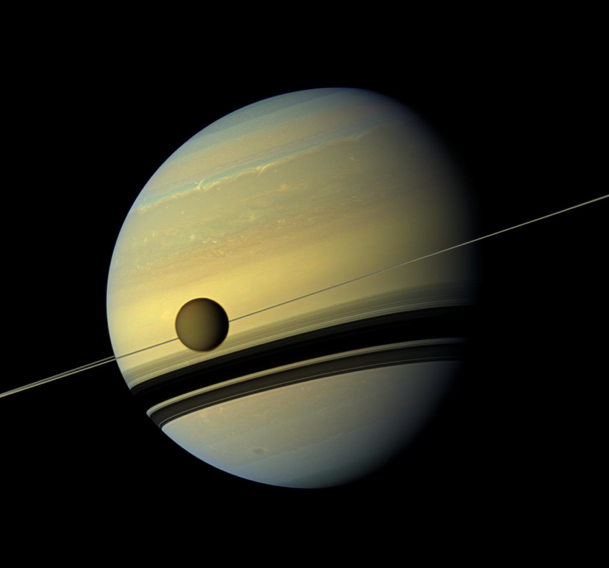

Discovered in 1655 by Dutch astronomer Christiaan Huygens, Titan is one of Saturn’s 62 moons, named for a race of giants in Greek myth who were Saturn’s brothers and sisters. Over 5000 km in diameter, it’s roughly twice the size of our own Moon and is one of the largest moons in our solar system, second only to Jupiter’s Ganymede. It’s even bigger than the planet Mercury, and is covered with an orange haze that shields the secrets of its surface. That alone makes it interesting, but a glimpse into the workings of the planet makes it more intriguing still—astronomers even believe Titan could harbour life.
In the 1980s, the Voyager 1 and 2 spacecraft flew past Titan; in the 2005 Huygens probe parachuted through its atmosphere and landed on the surface; and the Cassini spacecraft still studies Titan from its orbit around Saturn. Their images and measurements have revealed a vibrant alien world beneath the haze—complete with rivers, lakes, and ice volcanoes.

Titan is an incredibly frigid place, with an average temperature of -178 degrees Celsius (-289 Fahrenheit)—too brutally cold for life as we know it, but still of incredible interest to astrobiologists. It’s the only moon known to have an atmosphere—a thick and cloudy one, composed primarily of nitrogen—and it also exhibits weather and changing seasons. The orange haze that shrouds its surface is made up of trace gases such as benzene and hydrogen cyanide, and at the pole closest to the sun, sunlight heats the toxic orange haze and makes it circulate towards the other pole, so the gases concentrating there. Since a year on Titan lasts almost 30 Earth years, each season is 7 years long.
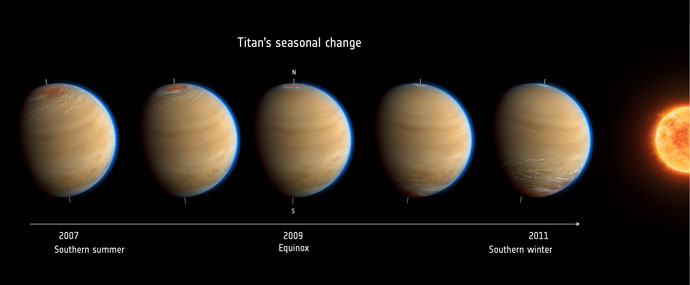
However, unlike Earth, its weather system is methane-based—and aside from Earth, Titan is the only object in the solar system to have permanent bodies of liquid on its surface, including an enormous river system that flows 400km across the moon’s surface to meet a large sea.
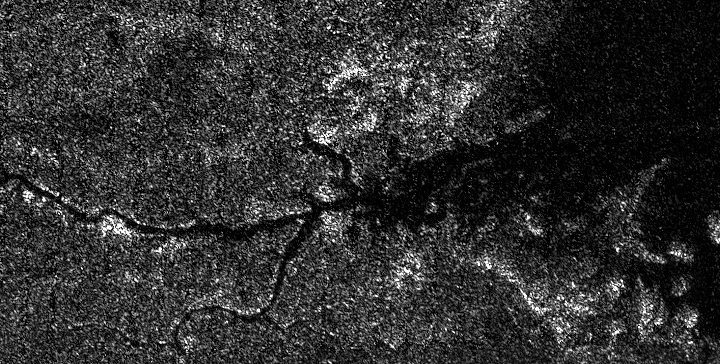
The darkness of the river in the image indicates a smooth surface, which in turn indicates that the river is not a dry bed, but filled with liquid—but this liquid is likely methane or ethane, which are more closely related to gasoline than water. Even though the mechanics seem to be similar, Titan’s weather would be alien to us because the skies fall with methane rain and lakes and oceans pool with liquid methane—but still, this presents possibilities of methane-based life.
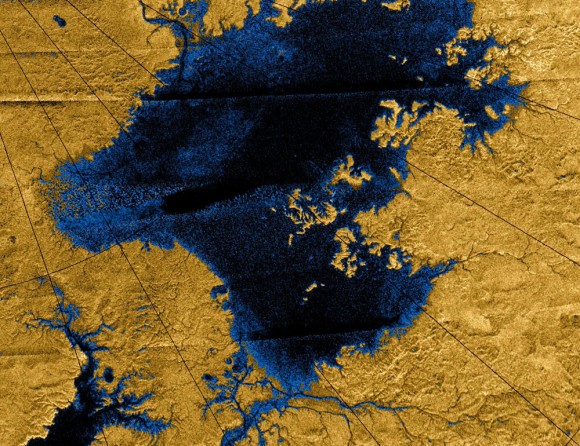
It is also suspected that Titan harbours cyrovolcanoes, which spew water ice and hydrocarbons into the atmosphere instead of lava. Speculations began after NASA’s Cassini spacecraft captured images of a landform on Titan’s surface called Sotra Facula. The images showed three conical features with material flowing from them, their peaks up to 1,500 metres tall, as well as several pits equally as deep. Researchers gravitated towards the idea that these landforms were cyrovolcanoes, as it would help explain a long-standing mystery of Titan’s thick, methane- and nitrogen-filled atmosphere. Calculations show sunlight would have broken the methane down long ago if something hadn’t been replenishing it, and a cyrovolcano is a good candidate—it could erupt methane, dragging it from the planet’s interior into the atmosphere.
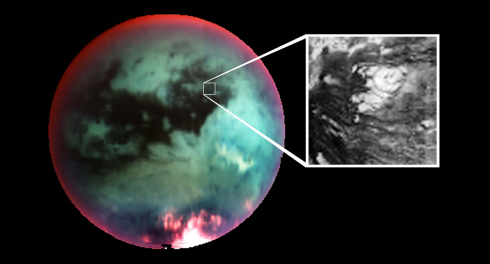
However, these intriguing surface features could have also been created by weather and meteorite strikes than by volcanic activity, and it is difficult to tell without further data. Researchers believe cyrovolcanoes might be fairly common on the frigid moons of the outer planets—one has been confirmed on another of Saturn’s moons, Enceladus—which is incredibly interesting, because volcanic activity would prove that Titan is an active world, and could increase the likelihood that this huge, distant moon may harbour life. While searing lava destroys life on Earth, ice volcanoes on Titan would provide a way to mix complex chemicals from the surface and the interior. It could bring life forms up to the surface so our instruments have a better chance of detecting them—because fascinatingly, Titan seems to have subsurface oceans.
Further data from Cassini indicates that Titan has a layer of liquid water under its icy outer shell. The evidence is tidal—as Titan orbits Saturn, the planet’s powerful gravitational pull stretches and deforms the moon, like pulling and stretching an elastic band. If Titan were solely composed of rock, this stretching would only cause bulges (tides) of about 1 metre, but instead the moon experiences tides of about 10 metres—suggesting that its interior is not entirely solid. This ocean may not be enormous or deep; just a liquid layer between the solid mantle and the external icy shell would be enough to compress and bulge as Cassini has observed. Since Titan’s ice surface is composed mostly water ice, researchers believe its ocean could be liquid water.
However, just the presence of an ocean alone does not indicate life—researchers think that life is more likely to occur when the water comes into contact with rock, and we can’t currently tell if this exists beneath the surface.
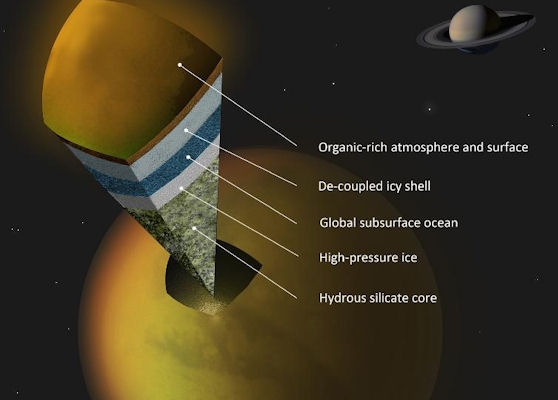
Another intriguing phenomenon is the hydrogen gas flows through its atmosphere, and yet there is a lack of the chemical on the planet’s surface—so how did it disappear? One theory suggests that hydrogen-breathing, methane-based life forms consume the gas, similar to how we consume oxygen on Earth.
Liquid water, a possibly active interior, complex chemistry, a thick atmosphere, seasons, weather… All of these factors reflect the environment of life as we know it, so researchers have long thought that Titan is an excellent candidate to harbour life. None of these factors alone are solid evidence for life—they are just conditions necessary for it—but Titan is a fascinating place deserving of further study. Since its nitrogen-rich atmosphere is similar to Earth, just significantly colder, it also demonstrates how atmospheres of cold moons and planets behave, and thus allows us to speculate about how the atmospheres of exoplanets far from their stars might behave.
But our questions about Titan will remain unanswered until we obtain sufficient evidence to draw conclusions—but to do this, we need data. Two possible missions have recently been proposed. The first is the Titan Mare Explorer (TiME), which would have sent a floating buoy to land in Titan’s methane sea and measure the chemistry and organic composition, study the sea’s interaction with the atmosphere, and basically perform the first nautical exploration of this extraterrestrial ocean. It also would have observed Titan’s methane cycle to help us compare it to the water cycle on Earth. TiME was proposed to launch in 2016, but unfortunately it lost its funding to a Mars mission.
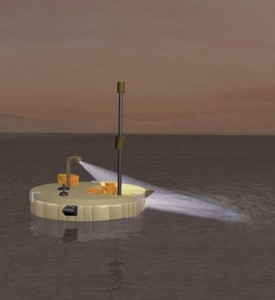
Another possibility, however, is the Titan Saturn System Mission (TSSM), which is a proposed exploration of Saturn, Titan, and Enceladus—focusing on the complex phenomena the Cassini spacecraft has already noted. It is proposed to launch in 2020 and reach Titan by 2029, and during its 4-year-tenure, it would spend time circumnavigating Titan and studying its astrobiological potential. The mission consists of an orbiter and two Titan exploration probles—one that’s basically a hot air balloon, and another that land on the methane seas. One of the proposals for this second lander is the lake-lander of the discarded TiME mission, which will hopefully be included. TSSM, if it goes ahead, would be the first mission to extensively survey the organic chemistry and climate of the land, sea, and air of another world.
If life is detected on Titan, it would undoubtedly be moving and crucial to us as a species—not only because it’s the first extraterrestrial life we have detected, but also because it would behave differently to the water-based, oxygen-breathing life we’ve developed here. Even if life has not yet developed on Titan, the chemistry for life to form is present, so just give the moon four billion years…and who knows?
Fuge L (2013-02-13 07:53:51). Searching for Life on Titan. Australian Science. Retrieved: Jul 18, 2025, from https://ozscience.com/space/searching-for-life-on-titan/
 Follow
Follow
1 thought on “Searching for Life on Titan”
Comments are closed.